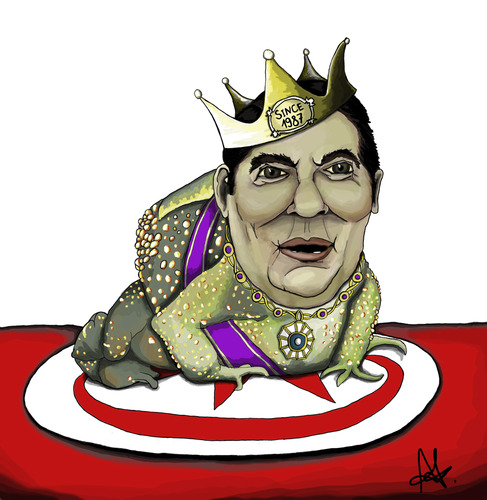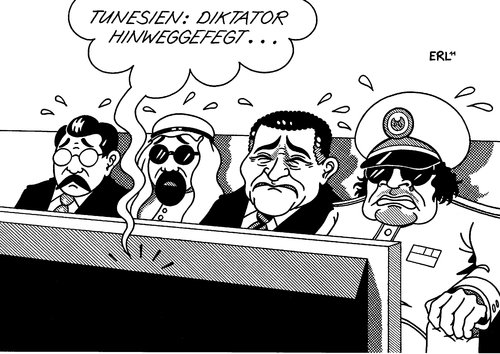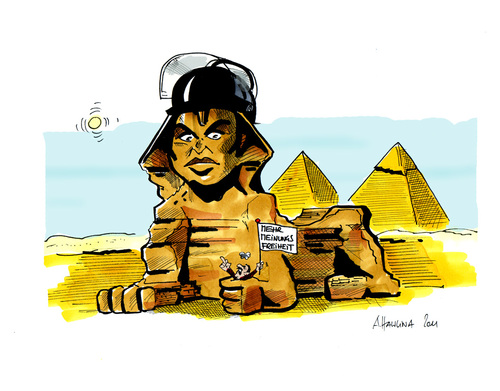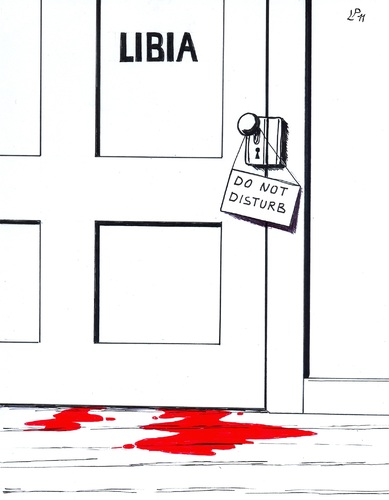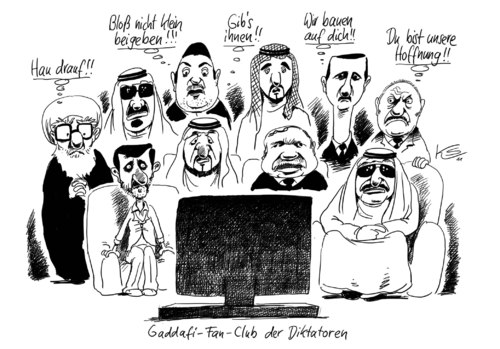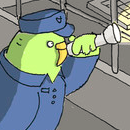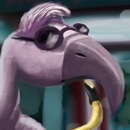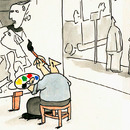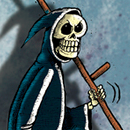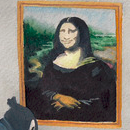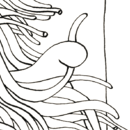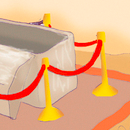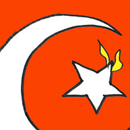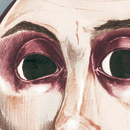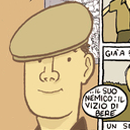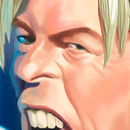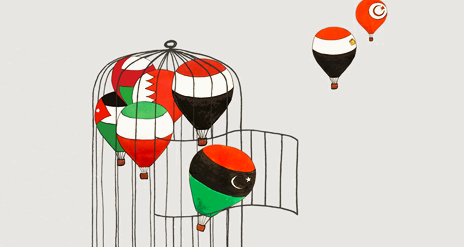
Nobody can predict what will come out of early 2011′s uprisings in North Africa and the Middle East and I am not going to try. What I can do, however, is to try to show how the treatment of the movements developed here on toonpool.com.
Pre-2011
While there are a few artists on toonpool.com who hail from countries like Egypt, Syria, Jordan, or Morocco, cartoons on this region’s domestic issues have been relatively few.
There is a single caricature of Tunisia’s Zine El Abidine Ben Ali and a handful of Hosni Mubaraks. A considerable amount of older cartoons tagged “Egypt” are basically mummy jokes. There is a bit more on Libya and Muammar Gaddafi, probably because he is the most flamboyant of the three and because of his four-decade history of insane supervillainity. Still, despite media stunts such as his 2009 call for dissolving Switzerland, there is not much to be found.
Today
Things have changed a lot since. For example, search results for “Egypt” have gone up by 125 per cent in the last three months while “Tunesien” went up by 440 per cent – if admittedly from a much lower number. This development started when protests in Tunisia made it into Western media.
I created the little infographic below to make it easier to follow the sequence of events. The dates are mostly taken from Wikipedia pages so don’t use them for any thesis you might be writing. I decided to stick with the events in Tunisia, Egypt, and Libya since it would have been too crowded had I included events in Bahrain, Yemen, Jordan, etc. Also, there are hardly any cartoons on events there.
Tunisia
The first cartoon that dealt with the situation in Tunisia was the “Ben Ali Frog Prince” by German artist Anitschka. It was posted on January 2, about two weeks into the protests. It remained the only one for more than a week. In fact, only three or four pieces werde added before Ben-Ali stepped down on January 14. The last of the three was, in fact, added on January 14, but before the President had fled the country.
Unsurprisingly, the number of cartoons on the situation in Tunisia rose considerably in the following days. Most of these cartoons can roughly be sorted into three categories: “making fun of Ben Ali” (e.g. this one), “poetic celebratory” (e.g. this one), and “who will be next?”. To me, the latter is the most interesting type since it showed up as early as January 16 and – with some variations – is still in use as of today.
The set of endangered leaders varies depending on the artist. Gaddafi and Mubarak are usually there – they were even before revolutions in their countries got serious. Among the others are Mahmud Ahmadinejad, Saudi Arabia’s King Abdullah, Syria’s Bashar al-Assad, Abdelaziz Bouteflika from Algeria, and, somewhat unexpectedly, Zimbabwe’s Robert Mugabe. (sample cartoons: 1,2,3,4,5).
Cartoons that deal with Tunisia and do not refer to it as part of a larger Arabian revolution disappeared by early February, even though the demonstrations continued. Cartoons are after all part of the international news cycle and public attention had moved east by then.
Egypt
Cartoons dealing with the demonstrations in Egypt first showed up in the afternoon of January 26 – I think this was the first one. Like most Egypt cartoons that would follow, these early ones made extensive use of pyramids, sphinxes, and mummies.
The ‘Egypt’ cartoons emphasize the role played by the internet, Facebook, Twitter and the like to a greater extent than the ‘Tunisia’ ones. Mr. Mubarak’s brilliant move to shut down the internet on January 28 certainly contributed to this (examples here, here, here & here).
Cartoons from the following two weeks tend to show Mr. Mubarak clinging to power (1,2,3) or his time running running out (1,2,3). Comments on Europe’s and America’s role in the conflict also show up more often than with Tunisia (e.g. here, here & here). Mubarak finally left on February 11 and the number of Egypt cartoons dwindeled down a few days later.
Libya
Toonpool.com members began to shift their attention to Libya around February 17 when reports about armed forces shooting at demonstrators hit the news. The first few posts were caricatures of Colonel Gaddafi that – I would guess – the artists still had in stock (1,2,3). The first proper cartoon (left) arrived very early on Februar 20.
In the following weeks the majority of “Libya cartoons” either made fun of Gaddafi as they had done with Mubarak (1,2,3) or illustrated violent actions of the regime (1,2,3). As the violence continued, the hopeful cartoons got fewer and fewer. On February 6 one member posted a telling variation of the “who will-be-next cartoon” mentioned above:
The other Arabian leaders threatened by uprisings are now cheering for Colonel Gaddafi’s troops hoping that the wave of revolutions wave will break in Libya.
It’s impossible to tell what will happen next. Will NATO establish a “no fly zone”? And, if they do, what will be the results? In any case, there will be cartoons that comment on the outcome.
PS: Finding a comprehensive list of cartoons on the Arabian revolutions is a bit tricky. For this article I used both our toonpool.com collections and the “Pro Search”. The best I can offer you is a general collection, one on Tunisia and one on Egypt. These may not include all cartoons on the matter, very often because of differing tagging conventions. They also tend to include cartoons that are onely remotely related. After all there are downsides to having an archive of more than 10,00 cartoons by over 2000 artists.
images: “Arab Revolution” by No, “Arabian Spring” by Samir Alramahi
]]>Personal Favorite
]]> Elihu Duayer is a new member from Rio de Janeiro. Elihu has been working for major Brazilian magazines since the 1980s.Perhaps not surprisingly, if you consider both Brazil’s ecological riches and its economic growth, several of his cartoons and illustrations concentrate on environmental issues. His “Prison City”, “Amazonian Eden”, and his portrait of unionist and environmental activist Chico Mendes all are good examples. Again other drawings deal with topics like generational misunderstandings, racism, and new technologies. I am sure that Elihu also does simple gag cartoons though – after all he has been working for MAD magazine.
Elihu Duayer is a new member from Rio de Janeiro. Elihu has been working for major Brazilian magazines since the 1980s.Perhaps not surprisingly, if you consider both Brazil’s ecological riches and its economic growth, several of his cartoons and illustrations concentrate on environmental issues. His “Prison City”, “Amazonian Eden”, and his portrait of unionist and environmental activist Chico Mendes all are good examples. Again other drawings deal with topics like generational misunderstandings, racism, and new technologies. I am sure that Elihu also does simple gag cartoons though – after all he has been working for MAD magazine.
Cartoons of Interest
Personal Favorite
]]>
